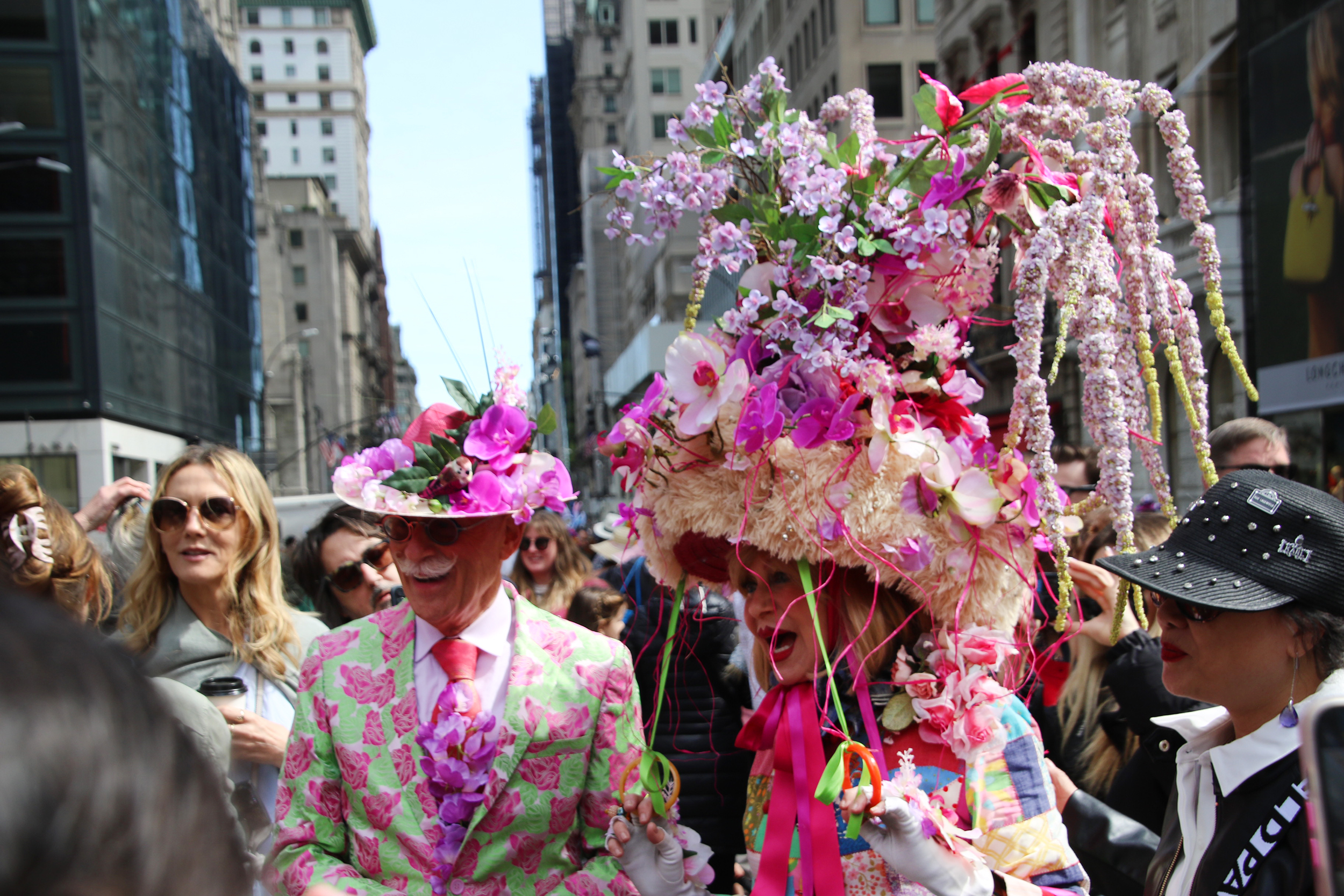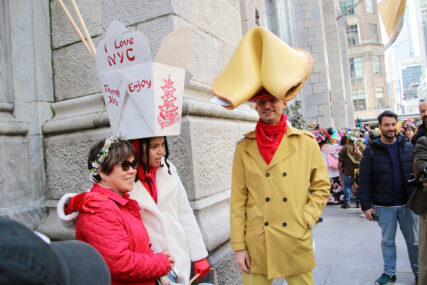
NEW YORK (RNS) — On Easter Sunday (April 20), Fifth Avenue erupted once again in a kaleidoscope of color, costumes and creativity as thousands gathered for the Easter Parade and Bonnet Festival.
The post-Mass procession of chicly dressed churchgoers that began in the 1870s has since evolved into a pluralistic and theatrical celebration. Today, it is less about organized religion and more about individual expression.
As parade-goers show off vibrant bonnets adorned with twigs and feathers, sparkly bunny ears, flower crowns, animal masks, painted faces, rainbow signs and even marijuana symbols, the event seems more like a jubilant and even queer-spirited spring ritual. If Easter in Gilded Age Manhattan was an affair of pearl and piety for the white, wealthy and conservative social elites, the 2025 edition more closely resembles a costume ball open to all.
Sunday morning, a long line formed outside St. Patrick’s Cathedral for the 10 a.m. Mass, which is reserved for local parishioners and those who could score a free ticket. But just outside, rainbow flags waved and some scantily dressed revelers posed for photos on the cathedral steps.
Emma Roads, who attended Easter Mass at St. Patrick’s, described the mood on the cathedral’s steps as chaotic, ironic and empowering.
“Obviously it’s pointed to have a gay celebration on the steps of the Catholic church, but also I think it slays,” Roads said. “I am Catholic, and I think both the line of people going into Mass are cool and I think the people on the steps are cool.”
New Yorkers, in their truest form, coexisted.
“I believe if we are listening to the words of Jesus, it’s about acceptance and accepting all people,” said Steven Menendez, a fine art photographer stationed atop the cathedral stairs dressed in large white wings and a sparkly gray toga. “Unconditional love: That is the message I am here to spread.”
Of his look, he said it was “as if God went to the discotheque.” He waved a rainbow flag with “PEACE” written on it as passersby clambered for photos.
“I am religious, but I am more spiritual,” he added. “I have studied many different spiritual, religious and metaphysical teachings for over 30 years.”
Patricia Fox, a fashion designer from the Upper West Side, has been attending the Easter Parade for over a decade. She stood in the center of flashing cameras alongside her husband, Howard, wearing what looked like a large bouquet of orchids intertwined with cherry blossom branches. The headpiece took 35 hours to make, she said, but her dark red lips smiled easily.
“The Bonnet Festival is an old tradition for churchgoers from the 1800s. St. Patrick’s Cathedral is famous,” Fox said. “It’s really not so much about who you are, it’s about welcoming diversity and individuality.”
View this post on Instagram
From its origins when finely dressed Catholics strolled down Fifth Avenue post-Mass under the eyes of eager onlookers to the parade’s current free-form incarnation, the Easter Parade reflects changes in fashion but also changes in faith, identity and society. The centuries-old church bells atop New York’s first cathedral today echo amid the beats of loudspeakers, shrieks from excitable tourists and spontaneous street performances.
The parade’s cultural relevance was also cemented by the 1948 Technicolor musical “Easter Parade,” starring Judy Garland and Fred Astaire, portraying the event as a glamorous showcase of fashion and romance.
“I stitched most of my clothes myself,” said Adam Pajowski, a historical-costume designer from Queens who sported a dark blue top hat. “It definitely started out as a parade for, by and of rich people, but I love that it has become a democratic egalitarian space where people can just let their freak flag fly.”
Amid the celebration, a small group from the Catholic Worker movement — including Martha Hennessy, a peace activist and granddaughter of the Catholic activist Dorothy Day — stood quietly at the bottom of the church stairs holding signs to draw attention to the lives lost in Gaza.
“Two people have confronted me about the signs, but it actually turned into a good discussion,” said Bernie Connaughton, a longtime Catholic Worker member who held a sign that read “Pray for Peace in Gaza.”
Sandra and Kevin Gonzales waited patiently in line for Mass, which they have been coming to for four years. Sandra wore a subtle light pink headpiece and Kevin wore a sharp white fedora.

Sandra and Kevin Gonzales participate in the annual Easter Parade and Bonnet Festival on April 20, 2025, in New York City. (Photo by Fiona Murphy)
“The hat parade is very festive,” Kevin Gonzales said. “For the most part, people who attend the church keep it classy. I think it’s a good blend.”
Others, like Wayne Barr from Long Island, who had a cigar painted like a carrot dangling from his lips, attended Mass near his home and then came to the city for the parade. He planned to go home at 3 p.m., in time for the ham roast his wife prepared for dinner.
“I think the Easter Parade has become secularized, but we all know the meaning,” said Barr, wearing a tie decorated with rabbits. “If Christ didn’t rise, we all wouldn’t be out here.”

Evetta Petty, right, at the Easter Parade and Bonnet Festival on April 20, 2025, in New York City. (Photo by Fiona Murphy)
In a city that thrives on self-expression, the festival has transformed into a stage for personal identity, whimsy, protest and honoring the bonnet.
“I have been coming to the event for 20 years now, and it’s our national holiday,” said Evetta Petty, who owns Harlem’s Heaven Hats. “Within the African American community, we have a special relationship with hats. My grandparents wouldn’t even leave the house without a hat on.”
The modern Easter Parade is more about legacy than liturgy, and yet, New Yorkers of all creeds still turn up dressed to impress.
“We came because this is a New York tradition,” said Todd Mickets, who was dressed in a matching outfit with his partner. “I think that the holiday is what you make of it. … If it’s religious for you, that’s amazing. If it’s not, that shouldn’t mean that you shouldn’t be part of a city celebration.”


